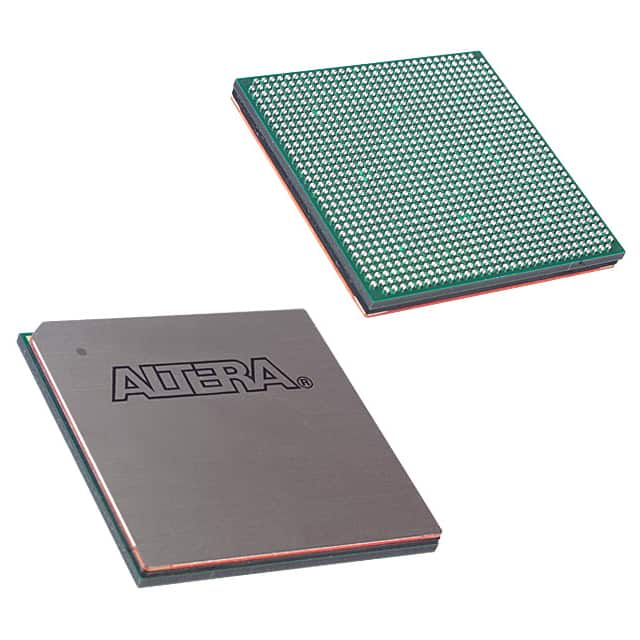EP1S40F1020C7N
Product Overview
Category
The EP1S40F1020C7N belongs to the category of programmable logic devices (PLDs).
Use
This device is primarily used for digital circuit design and implementation. It offers a flexible and customizable solution for various applications.
Characteristics
- Programmable: The EP1S40F1020C7N can be programmed to perform specific functions based on user requirements.
- High Integration: It integrates multiple logic gates, flip-flops, and other components into a single chip, reducing the need for external components.
- Versatile: It supports a wide range of applications due to its programmability.
- Low Power Consumption: The device is designed to operate efficiently with minimal power consumption.
- Fast Operation: It provides high-speed performance, enabling quick execution of complex logic operations.
Package
The EP1S40F1020C7N comes in a compact package that ensures easy integration into electronic circuits. The package type is C7N.
Essence
The essence of this product lies in its ability to provide a reconfigurable hardware platform for implementing digital logic designs.
Packaging/Quantity
The EP1S40F1020C7N is typically packaged in trays or reels, depending on the manufacturer's specifications. The quantity per package may vary, but it is commonly available in quantities of 100 or more.
Specifications
- Logic Elements: 40,000
- Maximum Frequency: 250 MHz
- Number of I/O Pins: 1,020
- Operating Voltage: 3.3V
- Technology: Field-Programmable Gate Array (FPGA)
- Package Type: C7N
- Temperature Range: -40°C to +85°C
Detailed Pin Configuration
The EP1S40F1020C7N has a total of 1,020 pins, which are assigned to various functions such as input, output, power supply, and configuration. The detailed pin configuration can be found in the product datasheet provided by the manufacturer.
Functional Features
- Reconfigurability: The EP1S40F1020C7N allows users to modify the logic design by reprogramming the device, providing flexibility for different applications.
- High-Speed Performance: With a maximum operating frequency of 250 MHz, this PLD offers fast execution of complex logic operations.
- Large Logic Capacity: The device's 40,000 logic elements enable the implementation of intricate digital circuits.
- I/O Flexibility: The EP1S40F1020C7N provides a wide range of I/O pins, allowing for versatile connectivity options with external devices.
Advantages and Disadvantages
Advantages
- Flexibility: The programmable nature of the EP1S40F1020C7N makes it adaptable to changing design requirements.
- Cost-Effective: By eliminating the need for custom-designed integrated circuits, this PLD reduces development costs.
- Time-Saving: The reprogrammability of the device enables faster prototyping and iteration cycles.
- Integration: The high integration level of the EP1S40F1020C7N simplifies circuit design and reduces board space requirements.
Disadvantages
- Learning Curve: Utilizing the full potential of the EP1S40F1020C7N may require a learning curve for designers unfamiliar with programmable logic devices.
- Limited Performance Optimization: Compared to application-specific integrated circuits (ASICs), PLDs may have limitations in terms of performance optimization for specific applications.
Working Principles
The EP1S40F1020C7N is based on field-programmable gate array (FPGA) technology. It consists of an array of configurable logic blocks interconnected through programmable routing resources. The device can be programmed using hardware description languages (HDLs) or specialized design software, which define the desired logic functions and interconnections.
Upon programming, the EP1S40F1020C7N configures its internal resources to implement the specified logic design. The reprogrammability allows for iterative design changes without requiring physical modifications to the circuitry.
Detailed Application Field Plans
The EP1S40F1020C7N finds applications in various fields, including:
- Communications: It can be used in networking equipment, routers, and switches for implementing custom protocols and data processing.
- Industrial Automation: The device enables the implementation of control systems, motor drives, and sensor interfaces in industrial automation applications.
- Consumer Electronics: It can be utilized in multimedia devices, gaming consoles, and smart home systems for customized functionality and enhanced performance.
- Automotive: The EP1S40F1020C7N is suitable for automotive applications such as engine control units, advanced driver-assistance systems (ADAS), and infotainment systems.
- Aerospace and Defense
기술 솔루션에 EP1S40F1020C7N 적용과 관련된 10가지 일반적인 질문과 답변을 나열하세요.
Sure! Here are 10 common questions and answers related to the application of EP1S40F1020C7N in technical solutions:
Q1: What is EP1S40F1020C7N? A1: EP1S40F1020C7N is a specific model of Field Programmable Gate Array (FPGA) manufactured by Intel.
Q2: What are the key features of EP1S40F1020C7N? A2: Some key features of EP1S40F1020C7N include 40,000 logic elements, 1.8V core voltage, 1020 pins, and support for various I/O standards.
Q3: What are the typical applications of EP1S40F1020C7N? A3: EP1S40F1020C7N is commonly used in applications such as industrial automation, telecommunications, automotive electronics, and high-performance computing.
Q4: How can EP1S40F1020C7N be programmed? A4: EP1S40F1020C7N can be programmed using Hardware Description Languages (HDLs) like VHDL or Verilog, which describe the desired functionality of the FPGA.
Q5: Can EP1S40F1020C7N be reprogrammed after initial programming? A5: Yes, EP1S40F1020C7N is a reprogrammable FPGA, allowing for flexibility in design changes or updates.
Q6: What tools are available for programming EP1S40F1020C7N? A6: Intel provides Quartus Prime software, which includes a suite of tools for designing, simulating, and programming EP1S40F1020C7N.
Q7: What is the power consumption of EP1S40F1020C7N? A7: The power consumption of EP1S40F1020C7N depends on the specific design and usage, but it typically ranges from a few watts to tens of watts.
Q8: Can EP1S40F1020C7N interface with other components or devices? A8: Yes, EP1S40F1020C7N supports various communication protocols like UART, SPI, I2C, and Ethernet, allowing it to interface with other components or devices.
Q9: Are there any limitations or considerations when using EP1S40F1020C7N? A9: Some considerations include power supply requirements, thermal management, and ensuring proper signal integrity in high-speed designs.
Q10: Where can I find more information about EP1S40F1020C7N? A10: You can refer to the official documentation provided by Intel, including datasheets, user guides, and application notes. Additionally, online forums and communities dedicated to FPGA development can be helpful sources of information.


